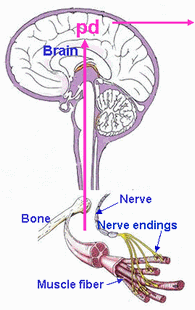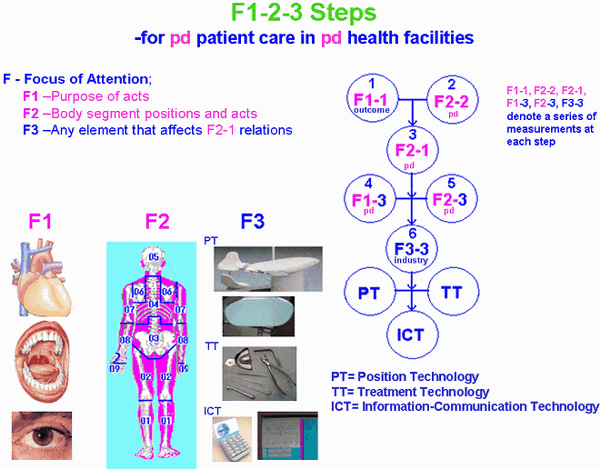13 pd/dp – derived from proprioceptor output
Much interest is currently focused on maintaining or restoring the abilities and health of the human body, but little interest is directed to the best use of the body for providing health care. As a result many patients are suffering from lack of skill in clinics and hospitals, ranging from unnecessary discomfort to death. Care providers also live with stress caused from chronic discomfort, distractions and unnecessary decisions. This stress is largely based on lack of skill or on clinic conditions that are incompatible with skill.
Proprioceptively derived (pd) positions, motions, and contacts provide the sensory and control base for clinical skill. Pd data are most accurately recorded from masked eyes tests with a focus of attention on muscle flex and extension, with a balanced head. With this approach, one can then believe the information that one receives from self.
Proprioceptors are sensory nerve endings that respond to stretch or muscles or related tissues. They are primarily in the body balance organ in the ear (vestibular cilia), muscles, tendons and joints. Proprioceptor input is stretch of tissues.

Proprioceptors thus sense positions and paths of motion of body parts. Dp, derivation from proprioceptors is based on proprioceptor-to-brain feedback with no influence from 1) habits, 2) exteroceptors that respond to light, color, sound, smell, touch and taste or 3) interoceptors that respond to pain and discomfort, which require no attention in normal conditions.
Pd/dp is the human centered base for appraisal of everything we do and everything we use to maintain or restore health. Conclusions from output of proprioceptors are feel-based and best tested with masked eyes.
Dp/pd skill is based on optimum use of one's body, which is acquired from derivations in open space with no preconceptions, and then muscle memory sets are established and maintained in pd settings.
pd-The Key to Linkage of Skills, Settings and Technology
Proprioceptively derived outcomes;
1. pd positions - for bodies in use and bodies at rest
2. pd body contacts - includes finger-tip and foot contacts
3. pd body space - includes pd paths of motion of body parts
Three pd outcomes INTEGRATE 3 types of technology for a health care system;
- POSITION technology (PT)
- TREATMENT technology (TT)
- INFORMATION-COMMUNICATION technology (ICT)

Performance logic & use of mi numbers
Questions & Answers:
Q) What is the main reason/purpose of masked eyes test/data in general?
A) To minimize bias from what we see and read. Think of Helen Keller life; one who lost ability to see and hear at early age (deaf and blind). She achieved in life far more than people who freely see and listen.
Q) What is the key to link skill with settings and technology?
A) The optimum use of the body begins with the use of the neck, from which we can feel optimal use of remaining muscles of the body. The use of the neck can be specified for both resting conditions and purpose-oriented activities. It is not only the key for determination of skill, settings and human interface with technology, but it also affects musculo-skeletal health which, in turn, may affect the health of other body parts.
Q) When should we be concerned with use or misuse of the human body?
A) We are concerned with it, when consistent accuracy of desired outcomes is required, when our judgements on skill, settings and technology affect the lives of many, and when we want to prevent or correct personal health problems caused by our bodies.
Q) What is derived from the first stage of proprioceptor output?
A) Body positions - for bodies in use and bodies at full rest.
Q) What is derived from the second stage of proprioceptor output?
A) The content of space that fits with desired outcomes in a unit of space for acts or procedure. The procedure can be directed to any part of the body. Desired outcomes are achieved with least waste of effort, space and depletable resources.
Q) What is derived from the third stage of proprioceptor output?
A) Needs of texture, sound, light and color on the surfaces in space that is specified from proprioceptor output.
Q) Who benefits from this information in Menu #13?
A) All who have a choice of health care settings as care receivers, care providers or setting manufacturers. Setting manufacturers are most important, because acts and procedures that affect care receivers and providers and their habits are outcomes of design of health facilities. In broader or global scopes of concerns, pd (proprioceptive derivation) has profound effects on safety, quality, access and cost of health care. In global data bank, pd/dp settings and care can be most effectively compared with all other options.